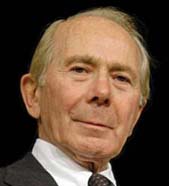By Lucy Komisar
AlterNet, March 17, 2005.

Maurice Hank Greenberg, one of the world‘s richest men, and head of AIG, one of the world‘s largest financial companies, was forced to resign this week as prosecutors closed in on him and the company.
Given his economic and political power, the fall of Maurice Hank Greenberg, the 59th richest man in America and CEO of the American International Group (AIG), the world’s second-largest financial conglomerate (after Citigroup), is stunning.
Greenberg’s net worth is $3.2 billion; he is the ninth-largest holder of AIG stock, with a $2.7 billion stake. Greenberg is a director and honorary vice chairman of the Council on Foreign Relations, where his portrait hangs in the elegant Rockefeller Room. A deep-pocketed Republican, he was on the short list for CIA director in 1995 after James Woolsey resigned in the wake of the Ames scandal.
Balding and short, Greenberg, 79, looks more like a munchkin than a spy chief. Perhaps in quest of a different image, in his youth he adopted the nickname Hank, after the baseball player. But he conjures up Napoleon more than the other Hank: the only relation to his namesake is a reputation for playing hardball.
Greenberg was elected AIG President in 1962, CEO in 1967 and Chairman in 1989. Henry Kissinger is chair of AIG’s international advisory committee, and board members include Barber Conable, former congressman and president of the World Bank, Carla Hills, former trade representative, and Richard Holbrooke, former UN ambassador.
AIG  is the largest U.S. underwriter of commercial and industrial insurance, with over $500 billion in assets, a market value of $190 billion, $40 billion in revenue and $5.8 billion in annual profits. For years, AIG earnings have beat the analysts by a penny a share, and that has been rewarded in the market place. Some people were skeptical, wondering how the company could fine-tune earnings so that they came out exactly one penny more. It was done using the offshore financial system.
is the largest U.S. underwriter of commercial and industrial insurance, with over $500 billion in assets, a market value of $190 billion, $40 billion in revenue and $5.8 billion in annual profits. For years, AIG earnings have beat the analysts by a penny a share, and that has been rewarded in the market place. Some people were skeptical, wondering how the company could fine-tune earnings so that they came out exactly one penny more. It was done using the offshore financial system.
AIG used offshore entities to escape even the lax enforcement of U.S. insurance regulators and the Securities and Exchange Commission (SEC). It used offshore tax havens such as Barbados and Bermuda to hide insider connections in supposedly arms-length deals and to move profits away from U.S. taxes. Regulators discovered some of these activities a decade or more ago, but Greenberg ” famous for political muscle and bullying – easily stone-walled and evaded punishment.
This week, Greenberg’s power evaporated. He resigned his CEO post, forced out by his board in an apparent effort to reduce the negative fallout they expect when New York Attorney General Eliot Spitzer and the SEC reveal findings into yet another Greenberg cook-the-books episode.
They are investigating a transaction Greenberg organized with Cologne Re, a reinsurance company, which increased AIG’s reserves by $500 million in late 2000 and early 2001, making its financial position appear better than it was. AIG used insurance to limit liability in the leases of its aircraft leasing unit – the International Lease Finance Corporation – and so reduce on the books the amount of debt used to finance some aircraft. It was a phony contract, because it guaranteed Cologne Re against losses.
Post-Enron, the SEC has punished AIG for helping other companies play fast and loose with accounting practices.
In 2003, the SEC sued AIG for fraud for helping Brightpoint Inc., an Indiana distributor of cell phones, hide $11.9 million in losses. AIG concocted a $15-million retroactive insurance policy for which Brightpoint paid $15 million in premiums. AIG refunded $11.8 million as phony claims payments that Brightpoint could claim as assets, allowing it to overstate its 1998 income by 61 percent. AIG paid $10 million to settle the suit.
In 2004, the SEC sued AIG for fraud for an Enron-style structured finance product it sold to PNC Financial Services, a Pennsylvania bank holding company. The scheme shifted $762 million in bad loans from PNC’s financial statements to special purpose entities, increasing its 2001 income by 27 percent. AIG paid $126 million to settle the case.

And four AIG executives have pleaded guilty to complicity in a big-rigging scheme organized by Greenberg’s son, Jeffrey, who was fired in October as CEO of Marsh & McLennan, the world’s biggest insurance broker.
Now, regulators are investigating other deals that AIG may have used to shine up financial statements for itself and its clients. There are at least two cases, one in each category, that were detailed in AlterNet in November and December, but never reported by the major mainstream press. They were early warnings of Greenberg’s lawbreaking that regulators chose to ignore.
Learning The Shell Game
In the late-80s, AIG set up Coral Re, an allegedly independent offshore reinsurance company, to allow it to illegally move debt off its books and violate rules about maintaining minimum levels of reserves required to pay off claims.
In the mid-80s, two of AIG’s reinsurers failed. AIG would have had to curtail writing new business, since rules require a certain ratio of assets to risk. Trevor Jones, an insurance investigator who runs Insurance Security Services in London, explained, Hank decided to set up Coral Re, move the debts he couldn’t claim as assets into this other company and say this new company owes this money. No other real company would play ball, because you are fiddling the accounts, moving your bad debts off your books.
AIG set up the shell company in Barbados, where capital requirements and regulation are minimal, where American regulators couldn’t readily discover AIG’s involvement and where, as an added incentive, it could evade U.S. taxes.

Coral Re was launched with a private sale of shares organized by Goldman Sachs, then headed by Robert Rubin, who would become President Clinton’s Treasury Secretary and is now chairman of the executive committee of Citigroup.
In the Dec. 1, 1987 stock placement memorandum, Goldman Sachs was quite to the point about the reason for setting up Coral Reinsurance Co. Ltd: “AIG’s interest in creating the Company is to create a reinsurance facility which will permit its U.S. companies to write more U.S. premiums. For a U.S.-domiciled company, a high level of surplus is required to support insurance premiums in accordance with U.S. statutory requirements. The statutory requirements in Barbados are less restrictive.
Goldman Sachs said recipients had to keep the information confidential, make no copies of the memo and return it on request. A no-risk deal was offered to the selected investors: L. Donald Horne, chairman of Mennen Co.; Charles Locke, chairman of Morton Thiokol; Kenneth Pontikes, former chairman of Comdisco; David Reynolds, chairman of Reynolds Metals; John Richman, former chairman of Kraft; and Samuel Zell, chairman of ltel Corp.
The Arkansas Finance and Development Authority (ADFA) ” under Gov. Bill Clinton ” was the lead investor with 84 of the 1,000 Coral Re shares. The deal violated the state’s constitutional ban on a state agency holding stock. Stock was also bought by AIG-affiliated insurance companies.
The stock cost $4 million per unit, but investors didn’t have to use their own money. They were loaned the amount by the Chicago branch of the Sanwa bank of Japan, with the stock invested in bank CDs as collateral. In case of default or desire to sell shares, Goldman Sachs guaranteed to take the stock or find a buyer. The investors could never make a profit or loss, but were guaranteed a fixed gain of $25,125 the first year and $45,225 each subsequent year, not bad for the use of their names. The directors never made any decisions and Coral Re never had an office: it was managed by American International Management Co, Ltd., a subsidiary of AIG.
AIG gave Coral Re $1.6 billion in premiums, much of which was deposited in Uberseebank, a private bank owned by AIG in the tax-haven of Switzerland.
AIG really paid all losses, using the bookkeeping device of increased premiums to Coral Re to take care of claims it had paid out. Everything about the deal said banking, not insurance.
Eventually, the scheme unraveled. In 1992 Delaware examiners auditing Lexington [an AIG subsidiary] smelled a rat, a former insurance regulator told me. AIG initially refused to provide examiners documents about Coral Re, and it took them a couple of years to nail the connection.
The Delaware report, finally issued in October 1996, suggested that Coral Re may be an affiliate of AIG. It described how AIG played an integral role in the creation of Coral Re; that its purpose was to reinsure risks for AIG companies; that virtually all Coral Re’s business originated from AIG units; and that Coral Re was managed by an AIG subsidiary. It concluded that the arrangement did not transfer risk and had to come off the books.
The regulator told me, Delaware should have suspended them, but did nothing. Insurance departments in Delaware, New York, Pennsylvania, and California met in 1996 to coordinate their reports. The regulator recalled, Nobody had any guts; they wanted Delaware to say Coral Re is affiliated and use that to go after them. Delaware reported what it found but didn’t rule they were affiliated. That would have meant hearings, endless hassles. And real punishment for AIG.
The Securities and Exchange Commission was also looking into Coral Re. The SEC was going to jump all over them, said the regulator. The SEC came to me, they wanted to know if we were going to rule they were affiliated. Then there would be penalties, because if AIG was affiliated with Coral and they hadn’t disclosed it in 10K filings, that’s a ‘no-no’ with the SEC.
It also would have been an issue for the IRS. If Coral Re was an AIG affiliate, it would have to pay taxes on its income. If it was independent, that money came tax-free.
But the federal and state agencies refused to take decisive action or order penalties. The delays and stonewalling allowed AIG to use Coral Re for more than eight years. Greenberg learned he was untouchable.
The Offshore Insurance Deal
Another shady AIG deal benefited one of the company‘s clients. AIG helped Victor Posner, a notorious crook, set up an offshore reinsurance company so that Posner could evade U.S. taxes. This was discovered in the early 90s, after the SEC prosecuted Posner for a fraudulent takeover scheme concocted with Wall Street thieves Michael Milkin and Ivan Boesky, ordered him to pay $4 million to fraud victims and banned him from serving as officer or director of any publicly-held company. (Posner died in 2002.)
New managers took over Posner’s NVF Corp., which ran a Delaware vulcanized rubber plant. Insurance agent Terry Mills, charged with examining company policies, discovered that NVF was paying AIG’s National Union Fire of Pittsburgh substantially over market for workmen’s compensation insurance.
AIG insured the NVF policy through Chesapeake Insurance, an offshore reinsurance company Posner owned in Bermuda. That meant AIG took its commission on the inflated NVF premium and sent the rest to Chesapeake. Posner wrote off the amount as a business expense and enjoyed the cash in Bermuda, tax free. Mills moved the NVF policy out of AIG. The Delaware Insurance Department learned of the scam, but did nothing.
Perhaps if regulators had cracked down a decade or more ago, and if AIG board members had put the brakes on, Greenberg might have been chastened and obeyed the law. Now, he has hired Martha Stewart’s criminal defense lawyer, Robert G. Morvillo, and been fired in disgrace.
AIG announced in corporate-speak that the Board of Directors has implemented its management succession plan with the removal of Greenberg in the best interest of AIG’s shareholders, customers and employees and announced a delay in the filing of its annual report to the SEC, the result of the management changes described above as well as the Company’s ongoing internal review of the accounting for certain transactions, which review was commenced in connection with previously announced regulatory inquiries.
Greenberg may be gone, but his legacy of shady deals won‘t be forgotten.

